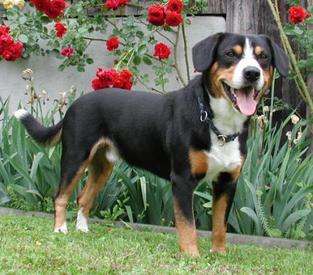
Native to the picturesque Entlebuch Valley region of Switzerland, the Entlebucher Mountain Dog is a rare breed and one of the four farm dogs originating from the country. The true heritage of the breed is subject to conjecture but it is believed to have descended from the guarding and fighting Mastiffs introduced by the Romans dating back over 2,000 years; the Entlebucher Mountain Dog, or 'Entlebucherhund' as it was earlier known, falls within the 'working' branch of canines as it was primarily bred as a cattle driver and versatile farm dog, being recognised by the American Kennel Club in 2011. The breed is rarely observed outside its country of origin.
Easily mistaken for similar-looking breeds, the Entlebucher Mountain Dog was once considered the same as the Appenzell Cattle Dog until such was disproven in 1913. The proportionate build of the Entlebucher Mountain Dog makes this an attractive and athletic-looking dog, with small triangular ears, compact feet, a deep chest for enhanced lung capacity aiding stamina, as well as a short coat in common tricolour variations of tan, black, and white, appearing symmetrically over the body.
Whilst not widely seen, its recognition by the American Kennel Club in recent years signals its growing prevalence as a highly sought domestic pet, popular with families and dedicated sole owners, as opposed to being purely bred for working fulfillments. The temperament of the breed is easy-going, affectionate and mannered, suiting it to any home setting wherein consistent obedience training is exercised. The average Entlebucher Mountain Dog weighs 25-30 kg with discrepancies across gender, and has a life expectancy of 10-15 years when cared for accordingly.
Boasting a relatively long life expectancy, the Entlebucher Mountain Dog is typically healthy and resilient. No breed-specific, genetic diseases are recognised in the breed, although due to its relative rarity, such is difficult to accurately assign. Documented health problems include various optical disorders, such as retinal atrophy and cataracts.
Do you own a Entlebucher Mountain Dog? Let others know what they're like!
Related products
Advantage 80 Spot On Flea Control Large Cats and Rabbits
from £10.89
Advantage 40 Spot On Flea Control Cats, Small Dogs and Rabbits
from £10.89
Advantage 100 Spot On Flea Control Medium Dog
from £10.89
Drontal Tasty Bone Wormer Tablets for Small & Medium Dogs (2 to 20kg)
from £1.69
Advantage 250 Spot On Flea Control Large Dog
from £10.89
FRONTLINE Plus Flea & Tick Treatment Dogs & Cats
from £16.29
TermaWorm™ Tablets for Cats & Dogs
from £1.59
Drontal Tasty Bone XL Wormer Tablets for Large Dogs (Over 20kg)
from £5.09